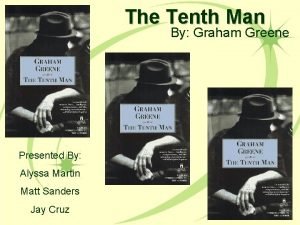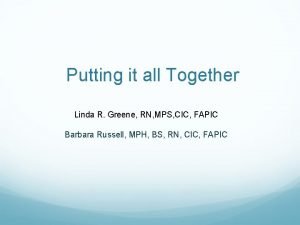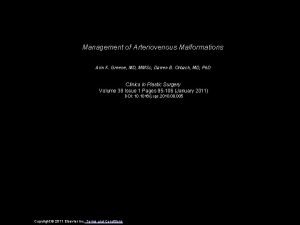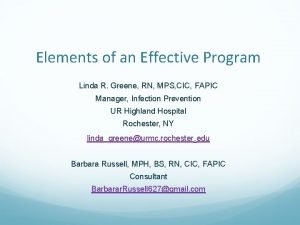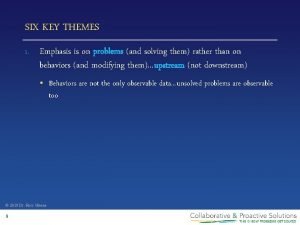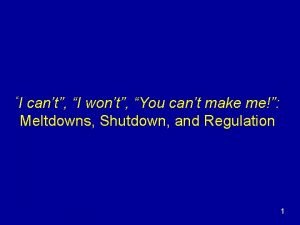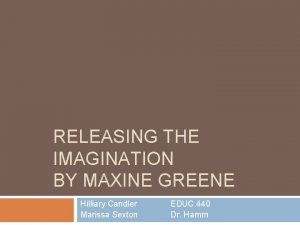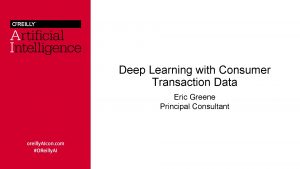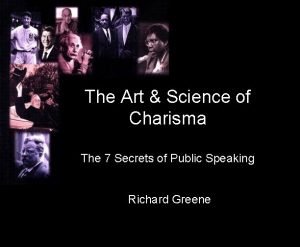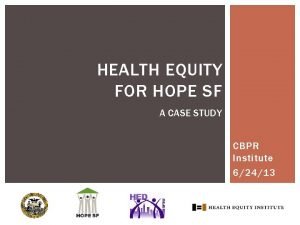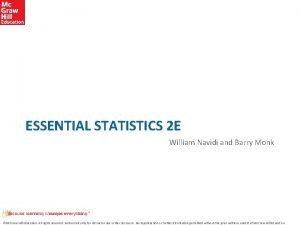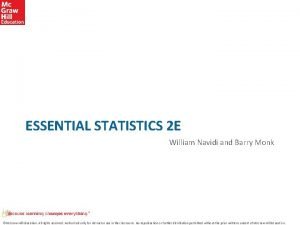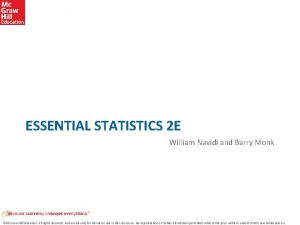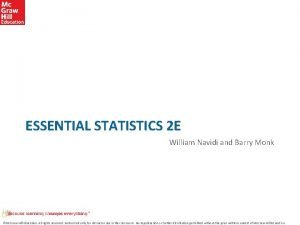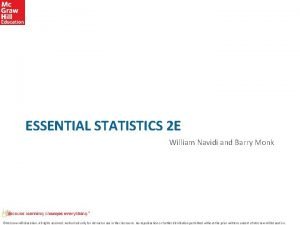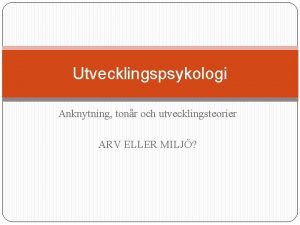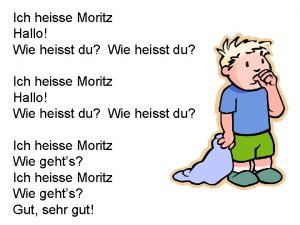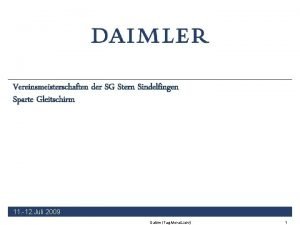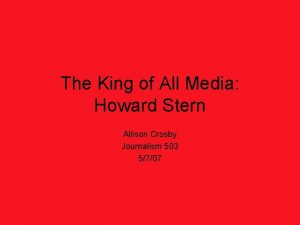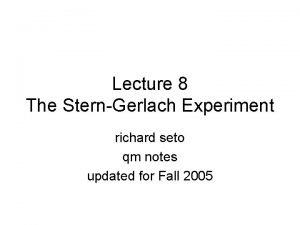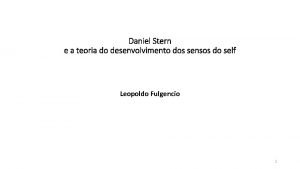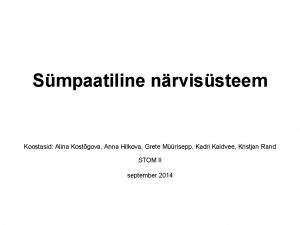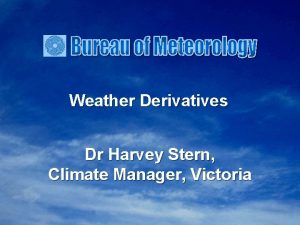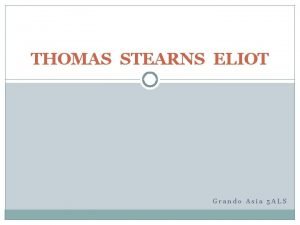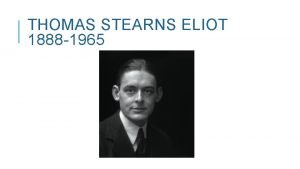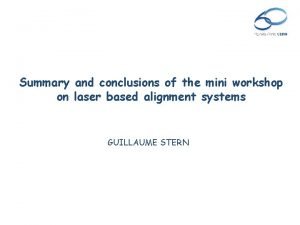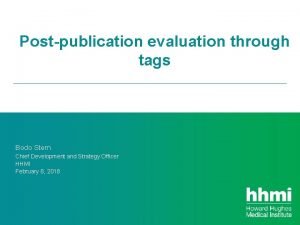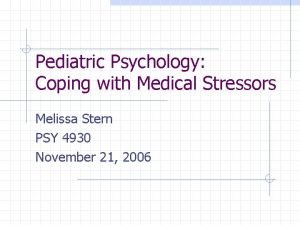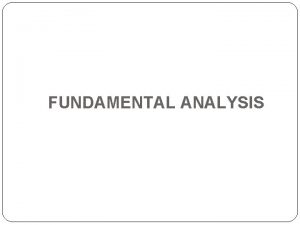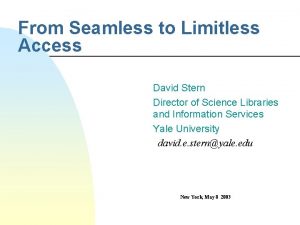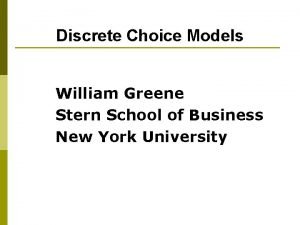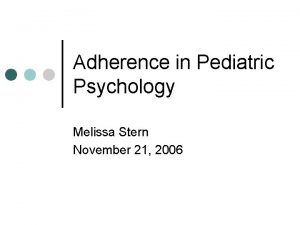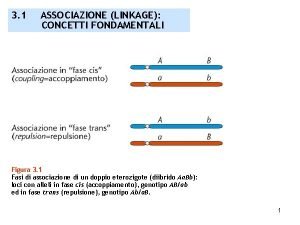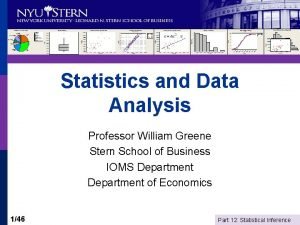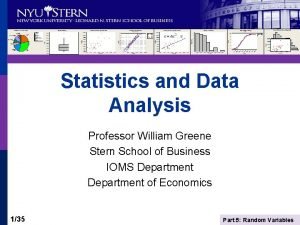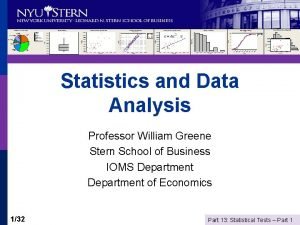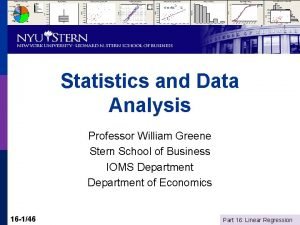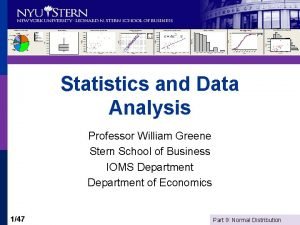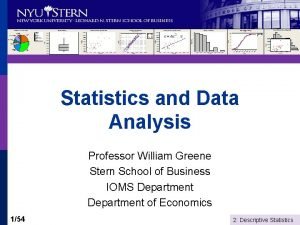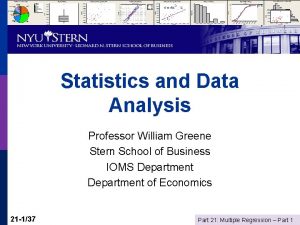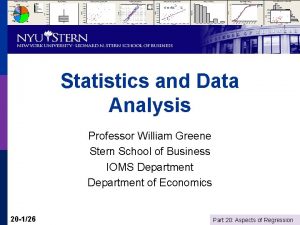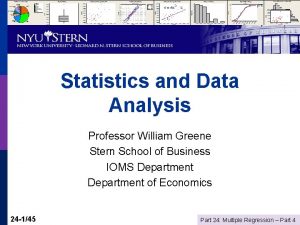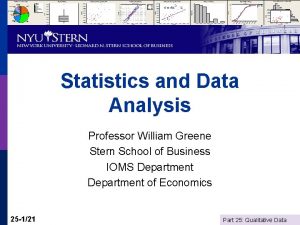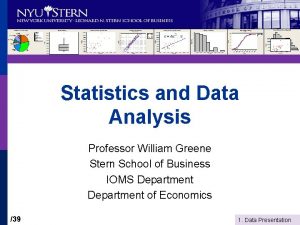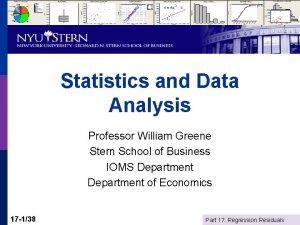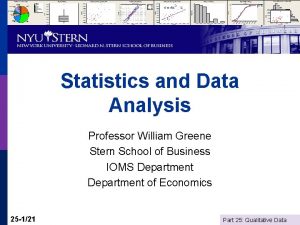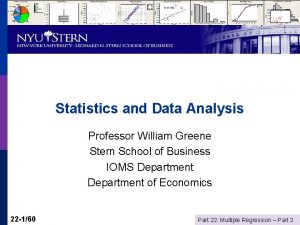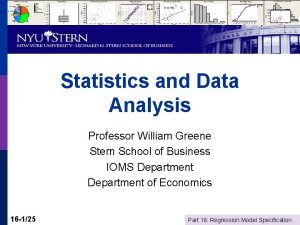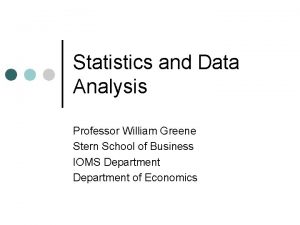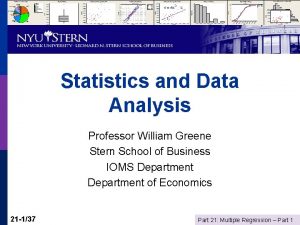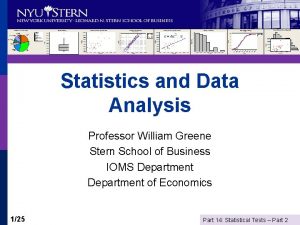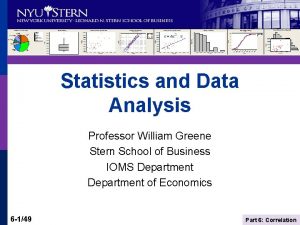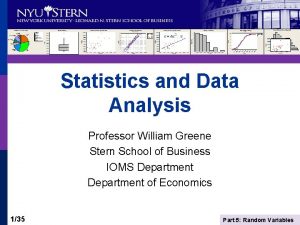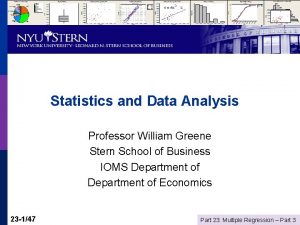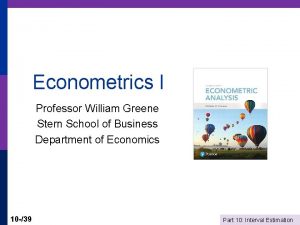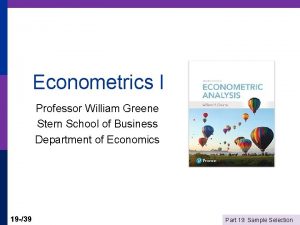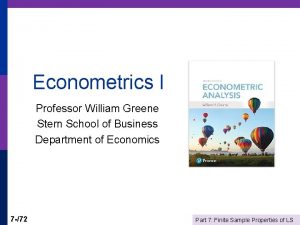Statistics and Data Analysis Professor William Greene Stern































































- Slides: 63

Statistics and Data Analysis Professor William Greene Stern School of Business IOMS Department of Economics 1/51 Part 3: Probability

Statistics and Data Analysis Part 3 – Probability 2/51 Part 3: Probability

Probability: Probable Agenda p p p 3/51 Randomness and decision making Quantifying randomness with probability n Types of probability: Objective and Subjective n Rules of probability Probabilities of events n Compound events n Computation of probabilities n Independence n Joint events and conditional probabilities n Drug testing and Bayes Theorem Part 3: Probability

What is Randomness? p p p 4/51 A lack of information? Can it be made to go away with enough information? Can it be ‘reduced’ with more information? Consider the process of ‘underwriting’ a loan. The lender accepts a probability of default. Through research, they hope to reduce that probability. But, it does not go to zero. Part 3: Probability

Decision Making Under Uncertainty: Why you want to understand probability p p p 5/51 Use probability to understand expected value and risk Applications n Financial transactions at future dates n Travel mode (or time) n Product purchase n Insurance and warranties – health and product n Enter a market n Any others? … Life is full of uncertainty Part 3: Probability

Probability p p Quantifying randomness The context: An “experiment” that admits several possible outcomes n Some outcome will occur n The observer is uncertain which (or what) before the experiment takes place Event space = the set of possible outcomes. (Also called the “sample space. ”) Probability = a measure of “likelihood” attached to the events in the event space. (Try to define probability without using a word that means probability. ) 6/51 Part 3: Probability

Types of Probabilities p p 7/51 Objective long run frequencies (the law of large numbers). E. g. , Prob(heads) in a coin toss. Subjective probabilities, e. g. , sports betting, belief of the risk of flying. Assessments based on personal information. Aggregation of subjective frequencies (parimutuel, sports betting lines, insurance, casinos, racetrack) Mathematical models: weather, options pricing Part 3: Probability

Assigning Probabilities to ‘Rare’ Events Colliding Bullets at Gettysburg There is no meaningful way to define the ‘sample space, ’ so no meaningful way to assign probabilities to these events. (The experiment cannot be repeated. ) 8/51 Part 3: Probability

Assign a Meaningful Probability? Yes, but very small. For all the criticism BP executives may deserve, they are far from the only people to struggle with such low-probability, high-cost events. Nearly everyone does. “These are precisely the kinds of events that are hard for us as humans to get our hands around and react to rationally, ” Quotes from Spillonomics: Underestimating Risk By DAVID LEONHARDT, New York Times Magazine, Sunday, June 6, 2010, pp. 13 -14. 9/51 On the other hand, when an unlikely event is all too easy to imagine, we often go in the opposite direction and overestimate the odds. After the 9/11 attacks, Americans canceled plane trips and took to the road. Part 3: Probability

Two holes in one on the same day on the same hole. Meaningful probability? Sample space can be defined. 67, 000 to one? Where did this come from? Since there have been more than 67, 000 rounds of golf played, does this calculation suggest this has been done before? 10/51 Part 3: Probability

210 Travelers between Sydney and Melbourne. One is picked at random: P(Car) 58 63 30 59 = 59/210 P(Ground) = (63+30+59) / 210 The connection between ‘data’ and probability. Assuming random sampling, based on the data above, if a random traveler is selected from the whole population (not just this sample), the probability that they would be a driver is (believed to be) 59/210 = 0. 281. Based on only 210 observations. Seems optimistic. If based on 210, 000 observations, more realistic. That is the implication of the law of large numbers. We will study this later. 11/51 Part 3: Probability

Rules of Probability p p p 12/51 An “event” E will occur or not occur. P(E) is a number that equals the probability that E will occur. By convention, 0 < P(E) < 1. Not-E = the event that E does not occur P(Not-E) = the probability that E does not occur. Part 3: Probability

Essential Results for Probability p p p 13/51 If P(E) = 0, then E cannot (will not) occur If P(E) = 1, then E must (will) occur E and Not-E are exhaustive – one of E or Not-E will occur. The event ‘E or Not-E’ must occur. Something will occur, P(E) + P(Not-E) = 1 Only one thing can occur. If E occurs, then Not-E will not occur – E and Not-E are exclusive. P(E and Not-E) = 0. They can’t both happen. Part 3: Probability

Compound Outcomes (Events) Define an event set of more than two possible equally likely elementary events. p Compound event: An event that consists of a set of elementary events. p The compound event occurs if any of the elementary events occurs. p 14/51 Part 3: Probability

Counting Rule for Probabilities for compounds of atomistic equally likely events are obtained by counting. p P(Compound Event) = p 15/51 Part 3: Probability

Compound Events: Randomly pick a BMW* E = A Random consumer’s random choice of exactly one model E = X Series = X 1 or X 3 or X 5 or X 6 P(X Series) = P(X 1) + P(X 3) + P(X 5) + P(X 6) = 1/10 + 1/10 = 4/10 P(Hot Sports Coupe) = P(i 8) + P(Z 4) = 1/10 + 1/10 = 2/10 Etc. 16/51 *This is not the entire line. Part 3: Probability

Counting the Number of Elements A set contains R items p The number of different subsets with r items is the number of combinations of r items chosen from R p p 17/51 (Derivations, see the Appendix) Part 3: Probability

How Many Poker Hands? How many 5 card hands are there from a deck of 52? R=52, r=5. p There are 52*51*50*49*48)/(5*4*3*2*1) 2, 598, 960 possible hands. p 18/51 Part 3: Probability

Probability of 4 Aces in a 5 Card Poker Hand 19/51 Part 3: Probability

The Dead Man’s Hand p The dead man’s hand is 5 cards, 2 aces, 2 8’s and some other 5 th card (Wild Bill Hickok was holding this hand when he was shot in the back and killed in 1876. ) The number of hands with two aces and two 8’s is 44 = 1, 584 p The rest of the story claims that Hickok held all black cards (the bullets). The probability for this hand falls to only 22/2598960. (The four cards in the picture and one of the remaining 22. ) Some claims have been made about the 5 th card, but no one is sure – there is no record. p http: //en. wikipedia. org/wiki/Dead_man's_hand 20/51 Part 3: Probability

Some Poker Hands Royal Flush – Top 5 cards in a suit Straight Flush – 5 sequential cards in the same suit 4 of a kind – plus any other card 21/51 Full House – 3 of one kind, 2 of another. (Also called a “boat. ”) Flush – 5 cards in a suit, not sequential Straight – 5 cards in a numerical row, not the same suit Part 3: Probability

Probabilities of 5 Card Poker Hands http: //www. durangobill. com/Poker. html 22/51 Part 3: Probability

Odds (Ratios) 23/51 Part 3: Probability

Odds vs. 5 Card Poker Hands Poker Hand Combinations Probability Odds Against -------------------------------------Royal Straight Flush 4 . 0000015391 649, 729: 1 Other Straight Flush 36 . 0000138517 72, 193: 1 Straight Flush (Royal or other) 40 . 0000153908 64, 973: 1 Four of a kind 624 . 0002400960 4, 164: 1 Full House 3, 744 . 0014405762 693: 1 Flush 5, 108 . 0019654015 508: 1 Straight 10, 200 . 0039246468 254: 1 Three of a kind 54, 912 . 0211284514 46: 1 Two Pairs 123, 552 . 0475390156 20: 1 One Pair 1, 098, 240 . 4225690276 1. 4: 1 High card only (None of above) 1, 302, 540 . 5011773940 1: 1 Total 2, 598, 960 1. 00000 http: //www. durangobill. com/Poker. html 24/51 Part 3: Probability

Joint Events p p Two events: A and B One or the other occurs is denoted A or B ≡ A B Both events occur is denoted A and B ≡ A B Neither event occurs is Not-A and Not-B. Independent events: Occurrence of A does not affect the probability of B An addition rule: P(A B) = P(A)+P(B)-P(A B) The product rule for independent events: P(A B) = P(A)P(B) 25/51 Part 3: Probability

Joint Events: Pick a Card, Any Card Event A = Diamond: P(Diamond) = 13/52 2♦ 3♦ 4♦ 5♦ 6♦ 7♦ 8♦ 9♦ 10♦ J♦ Q♦ K♦ A♦ p Event B = Ace: P(Ace) = 4/52 A♦ A♥ A♣ A♠ p Addition Rule: Event A or B = Diamond or Ace P(Diamond or Ace) = P(Diamond) + P(Ace) – P(Diamond and Ace) = 13/52 + 4/52 – 1/52 = 16/52 p 26/51 Part 3: Probability

Application: Orders arrive from 3 sources, Catalog, Repeat Sales, Phone and in 4 sizes, Small, Medium, Large, Huge. The last 4, 000 orders produced this table: Catalog Repeat Phone Total Small 1021 86 1497 2604 Medium 216 371 230 817 Large 109 308 86 503 Huge 14 49 13 76 Total 1360 814 1826 4000 Catalog and Repeat sales must go through an entry step. What is the probability that a randomly chosen order goes through this step (i. e. , is a Catalog or Repeat Sale order)? P(Catalog or Repeat) = 1360/4000 + 814/4000 =. 3400 +. 2035 =. 5435 Huge orders and phone orders are held for credit verification. What is the probability that a randomly chosen order is held for credit verification? P(Huge or Phone) 27/51 = P(Huge) + P(Phone) - P(Huge and Phone) = 76/4000 + 1826/4000 – 13/4000 =. 01900 +. 45650 + -. 00325 =. 47225 Part 3: Probability

Application of Joint Probabilities Survey of 27326 German Individuals. * Frequency in black, sample proportion in red. E. g. , . 04186 = 1144/27326, . 52123 = 14243/27326 Uninsured Insured Total Female Male Total 1144 1979 3123 11939 12264 24203 13083 14243 27326 Uninsured Insured Total Female Male Total . 04186 . 07242 . 11429 . 43691 . 44880 . 88571 . 47877 . 52123 1. 00000 * In the German system, ‘uninsured’ as above means does not purchase the ‘public’ insurance. Everyone has health insurance. Individuals may choose to buy a ‘private’ insurance policy instead of the public insurance. 28/51 Part 3: Probability

The Addition Rule - Application Uninsured Insured Total Female Male Total . 04186 . 07242 . 11429 . 43691 . 44880 . 88571 . 47877 . 52123 1. 00000 An individual is drawn randomly from the pool of 27, 326 observations. P(Female or Insured) = P(Female) + P(Insured) – P(Female and Insured) =. 47877 +. 88571 –. 43691 =. 92757 29/51 Part 3: Probability

Product Rule for Independent Events p Events A and B both occur. p Probability p If A and B are independent, P(A B) = P(A)P(B) 30/51 = P(A B) Part 3: Probability

Independent Events If these probabilities are correct, P(hit by lightning) = 1/3, 000 and P(hole in one) = 1/12, 500, then the probability of (Struck by lightning in your lifetime and hole-in-one) = 1/3, 000 * 1/12500 =. 00000003 or one in 37, 500. Has it ever happened? 31/51 Part 3: Probability

Product Rule for Independent Events p Example: I will fly to Washington (and back) for a meeting on Monday. I will use the train on Tuesday. Late or on time for the two days are independent. P(Late | I fly) =. 6. P(Not-Late|fly) = 1 -. 6 =. 4 P(Late | I take the train) =. 2. P(Not Late|Train) = 1 -. 2 =. 8 p What is the probability that I will miss at least one meeting? Monday Tuesday P(Late, Not late) P(Not late, Late ) P(Late, Late) P(Late at least once) 32/51 = = (. 6)(1 -. 2) (1 -. 6)(. 2) (. 6)(. 2). 48+. 08+. 12 =. 48 =. 08 =. 12 =. 68 Part 3: Probability

Joint Events and Joint Probabilities Marginal probability = Probability for each event, without considering the other. p Joint probability = Probability that two events happen at the same time p 33/51 Part 3: Probability

Marginal and Joint Probabilities Survey of 27326 German Individuals Consider drawing an individual at random from the sample. Female Male Total Uninsured . 04186 . 07242 . 11429 Insured . 43691 . 44880 . 88571 Total . 47877 . 52123 1. 00000 Marginal Probabilities; P(Male)=. 52123, P(Insured) =. 88571 Joint Probabilities; P(Male and Insured) =. 44880 34/51 Part 3: Probability

Conditional Probability “Conditional event” = occurrence of an event given that some other event has occurred. p Conditional probability = Probability of an event given that some other event is certain to occur. Denoted P(A|B) = Probability that A will occur given B occurs. p n 35/51 Prob(A|B) = Prob(A and B) / Prob(B) Part 3: Probability

Conditional Probability 210 Travelers between Sydney and Melbourne. One of the ground travelers is picked at random. What is the probability they are a car driver? P(Ground) = (63+30+59) / 210 =. 7238 P(Car) = 59/210 =. 2810 P(Car|Ground) = 59/(63+30+59) =. 3882 36/51 Part 3: Probability

Buying a BMW* A random buyer of one of these models (conditioning on these 10 models) is chosen. (1) What is the probability that they buy an X 5? 1/10 (2) Given that they will buy an X series, what is the probability that they buy an X 5? Prob(X 5|Xseries) = Prob(X 5 and Xseries)/P(Xseries) = (1/10) / (4/10) = 1/4 (Individual probabilities are surely not all 1/10. Market shares of these models differ) 37/51 *This is not the entire line. Part 3: Probability

. 40. 10. 05. 02. 07. 06. 04. 03. 02. 01 BMW has a 10% total market share in the car market. * The 10 models shown are 80% of BMW’s sales P(random car buyer buys a BMW) P(random car buyer buys one of these 10 models) P(random BMW buyer buys one of these 10 models) P(random car buyer buys an X series BMW) P(random BMW buyer buys an X series BMW) P(random car buyer buys a BMW not one of these 10 models) 38/51 All of the numbers in this example are completely fictitious. Part 3: Probability

Conditional Probabilities Company ESI sells two types of software, Basic and Advanced, to two markets, Government and Academic. Orders arrive with the following probabilities: Basic Advanced Total Academic. 4. 3. 7 P(Basic) P(Basic | Academic) P(Government | Advanced) 39/51 Government. 2. 1. 3 = = Total. 6. 4 1. 0 . 60. 4 /. 7 =. 571. 30. 1 /. 4 =. 25 Part 3: Probability

Conditional Probabilities Do women take up public health insurance more than men? Uninsured Female Male Total . 04186 . 07242 . 11429 P(Insured|Female) =P(Insured and Female)/P(Female) =. 43691/. 47877 =. 91257 Insured . 43691 . 44880 . 88571 P(Insured|Male) = P(Insured and Male)/P(Male) Total . 47877 . 52123 1. 00000 =. 44880/. 52123 =. 86104 Yes, they do. Notice that the joint probabilities might suggest otherwise, but they are the wrong probabilities to look at. 40/51 Part 3: Probability

The Product Rule for Conditional Probabilities p p For events A and B, P(A B) = P(A|B)P(B) Example: You draw a card from a well shuffled deck of cards, then a second one without replacing the first one. What is the probability that the two cards will be a pair? n n 41/51 There are 13 cards. Let A be the card on the first draw and B be the second one. Then, P(A B) = P(A)P(B|A). For a pair of kings, P(K 1) = 1/13. P(K 2|K 1) = 3/51. P(K 1 K 2) = (1/13)(3/51) = 1/(13 x 17). There are 13 possible pairs, so P(Pair) = 13(1/13)(3/51) = 1/17. Part 3: Probability

Litigation Risk Analysis: Using Probabilities to Determine a Strategy P(Upper path) = P(Causation|Liability, Document)P(Liability|Document)P(Document) = P(Causation, Liability, Document) =. 7(. 6)(. 4)=. 168. (Similarly for lower path, probability =. 5(. 3)(. 6) =. 09. ) Two paths to a favorable outcome. Probability = (upper). 7(. 6)(. 4) + (lower). 5(. 3)(. 6) =. 168 +. 09 =. 258. 42/51 How can I use this to decide whether to litigate or not? Part 3: Probability

Independent Events are independent if the occurrence of one does not affect probabilities related to the other. p Events A and B are independent if and only if P(A|B) = P(A). I. e. , conditioning on B does not affect the probability of A. p 43/51 Part 3: Probability

Independent Events? Pick a Card, Any Card P(Red card drawn) = 26/52 = 1/2 p P(Ace drawn) = 4/52 = 1/13. p P(Ace|Red) = (2/52) / (26/52) = 1/13 p P(Ace) = P(Ace|Red) so “Red Card” and “Ace” are independent. p 44/51 Part 3: Probability

Independent Events? Company ESI sells two types of software, Basic and Advanced, to two markets, Government and Academic. Sales occur randomly with the following probabilities: Basic Advanced Total Academic. 4. 3. 7 Government. 2. 1. 3 Total. 6. 4 1. 0 P(Basic | Academic) =. 4 /. 7 =. 571 not equal to P(Basic)=. 6 P(Government | Advanced) =. 1 /. 4 =. 25 not equal to P(Govt) =. 3 The probability for Advanced|Academic is different from the probability for Advanced|Government. They are not independent. 45/51 Part 3: Probability

Using Conditional Probabilities: Bayes Theorem Typical application: We know P(B|A), we want P(A|B) In drug testing: We know We need P(find evidence of drug use | usage) < 1. P(usage | find evidence of drug use). The problem is false positives. P(find evidence drug of use | Not usage) > 0 This implies that 46/51 P(usage | find evidence of drug use) 1 Part 3: Probability

Bayes Theorem 47/51 Part 3: Probability

Disease Testing p Notation n + = test indicates disease, – = test indicates no disease n D = presence of disease, N = absence of disease p Known Data n P(Disease) = P(D) =. 005 (Fairly rare) (Incidence) n P(Test correctly indicates disease) = P(+|D) =. 98 (Sensitivity) (Correct detection of the disease) n P(Test correctly indicates absence) = P(-|N) =. 95 (Specificity) (Correct failure to detect the disease) p Objectives: Deduce these probabilities n P(D|+) (Probability disease really is present | test positive) n P(N|–) (Probability disease really is absent | test negative) Note, P(D|+) = the probability that a patient actually has the disease when the test says they do. 48/51 Part 3: Probability

More Information p Deduce: Since P(+|D)=. 98, we know P(–|D)=. 02 because P(-|D)+P(+|D)=1 [P(–|D) is the P(False negative). p Deduce: Since P(–|N)=. 95, we know P(+|N)=. 05 because P(-|N)+P(+|N)=1 [P(+|N) is the P(False positive). p 49/51 Deduce: Since P(D)=. 005, we know P(N)=. 995 because P(D)+P(N)=1. Part 3: Probability

Now, Use Bayes Theorem 50/51 Part 3: Probability

Summary p p Randomness and decision making Probability n n p p Simple and compound events and constructing probabilities Joint events n n p 51/51 Sources Basic mathematics Independence Addition and product rules for probabilities Conditional probabilities and Bayes theorem Part 3: Probability

Appendix – Counting Rules 52/51 Part 3: Probability

Counting the Number of Events: Permutations and Combinations p p Permutations = Number of possible arrangements of a set of R items: E. g. , 4 kids, Allison, Julie, Betsy, Lesley. How many different lines that contain 3 of them? n n n 53/51 AJB, ABJ, AJL, ALJ, ABL, ALB, all with Allison first: JAB, JBA, JAL, JLA, JBL, JLB, all with Julie first. And so on… 24 different lines in total. Part 3: Probability

Counting Permutations p What’s the rule? n n n R items in total Choose sets of r items Order matters R possible first choices, then R-1 second, then R -2 third, and so on. p R × (R-1) × (R-2) × … ×(R-r+1) p 4 kids, 3 in line, 4× 3× 2 = 24 ways. p 54/51 Part 3: Probability

Permutations 55/51 Part 3: Probability

Permutations The number of ways to put R objects in order is R×(R-1)…(1) = R! E. g. , AJEL, ALEJ, AEJL, and so on. 24 possibilities p The number of ways to order r objects chosen out of R is p 56/51 Part 3: Probability

Permutations and Combinations E. g. , 8 Republican presidential candidates; How many ways can one order 2 of them? There are 8 possibilities for the first and 7 for the second, so p 8(7)=56 = 8!/(8 -2)! = 8!/6! p 57/51 Part 3: Probability

Combinations and Permutations p p 58/51 What if order doesn’t matter? E. g. , out of A, J, E, L, 12 permutations of 2 are AJ AE AL JE JL EL LE LJ EJ LA EA JA. Here order matters But suppose AJ and JA are the same event (order doesn’t matter)? The list double counts. The number of repetitions is the number of permutations of the r items, which is r!. Part 3: Probability

Combinations and Permutations The number of “combinations” is the number of permutations when order does not matter. 59/51 Part 3: Probability

Combinations and Permutations The number of “combinations” is the number of permutations when order does not matter. 60/51 Part 3: Probability

Some Useful Results 61/51 Part 3: Probability

Counting the Dead Man’s Cards The Aces 6: There are 6 possible pairs out of [A♠ A♣ A♥ A♦] (♠ ♣) (♠♥) (♠♦) (♣♥) (♣♦) (♥♦) The 8’s: There also 6 possible pairs out of [8♠ 8♣ 8♥ 8♦] (♠ ♣) (♠♥) (♠♦) (♣♥) (♣♦) (♥♦) There are 44 remaining cards in the deck that are not aces and not 8’s. The total number of possible different hands is therefore 6(6)(44) = 1, 584. If he held the bullets (black cards), then there are only (1)(1)(44) = 44 combinations. There is a claim that the 5 th card was a diamond. This reduces the number of possible combinations to (1)(1)(11). 62/51 Part 3: Probability

Types of Probabilities p p p 63/51 Physical events – mechanical. “Random number generators, ” e. g. , coins, cards, computers, horse races, dog races. Random number generators are not random. By setting the ‘seed, ’ a set of values can be repeated. (They are called ‘pseudo-random number generators. ) Part 3: Probability
 Aft end construction of ship
Aft end construction of ship Promotion from assistant to associate professor
Promotion from assistant to associate professor Kylie greene
Kylie greene The tenth man graham greene summary
The tenth man graham greene summary Stokes' theorem
Stokes' theorem The destructors graham greene
The destructors graham greene Adaptive challenges examples
Adaptive challenges examples Journey without maps
Journey without maps Robert greene shakespeare
Robert greene shakespeare Arin greene
Arin greene Linda r greene
Linda r greene Problem solving plan plan b flowchart
Problem solving plan plan b flowchart Ross greene plan a b c
Ross greene plan a b c Maxine greene releasing the imagination
Maxine greene releasing the imagination Ericka greene md
Ericka greene md Eric greene course
Eric greene course 7 secrets of the sensitive
7 secrets of the sensitive Uzuri pease-greene
Uzuri pease-greene Citl ucsc
Citl ucsc Introduction to statistics what is statistics
Introduction to statistics what is statistics Elementary statistics william navidi pdf
Elementary statistics william navidi pdf Essential statistics william navidi pdf
Essential statistics william navidi pdf Essential statistics william navidi pdf
Essential statistics william navidi pdf William navidi essential statistics pdf
William navidi essential statistics pdf William navidi essential statistics pdf
William navidi essential statistics pdf Personal network analysis
Personal network analysis Utvecklingsteorier
Utvecklingsteorier Stern village trumbull ct
Stern village trumbull ct Stern landing vessel
Stern landing vessel Dr theodore stern
Dr theodore stern Starboard and port side
Starboard and port side Experimento de stern gerlach
Experimento de stern gerlach Bow stern port starboard
Bow stern port starboard Poliengine reviews
Poliengine reviews Hallo wie heißt du
Hallo wie heißt du Ady stern
Ady stern Daniel stern model
Daniel stern model Sg stern sindelfingen
Sg stern sindelfingen Howard stern allison
Howard stern allison Race and resettlement act schindler's list
Race and resettlement act schindler's list Ben kingsley som itzak stern
Ben kingsley som itzak stern Stern-gerlach experiment lecture notes
Stern-gerlach experiment lecture notes Stern teoria
Stern teoria Indiaanlaste noolemürk
Indiaanlaste noolemürk Meaning of photomontage
Meaning of photomontage Frederick stern
Frederick stern Stern rudder ap world history
Stern rudder ap world history Dr harvey stern
Dr harvey stern Tom stern eliot
Tom stern eliot Tom stern eliot
Tom stern eliot Emotions stern
Emotions stern Guillaume stern
Guillaume stern Bodo stern
Bodo stern Flower morphology
Flower morphology Melissa stern psychologist
Melissa stern psychologist Stern stewart eva
Stern stewart eva Stern
Stern Stern
Stern Melissa stern psychologist
Melissa stern psychologist August stern
August stern Coefficiente di coincidenza genetica
Coefficiente di coincidenza genetica Fliegender stern kapitel 5
Fliegender stern kapitel 5 Stern-gerlach experiment conclusion
Stern-gerlach experiment conclusion Itzhak stern
Itzhak stern



